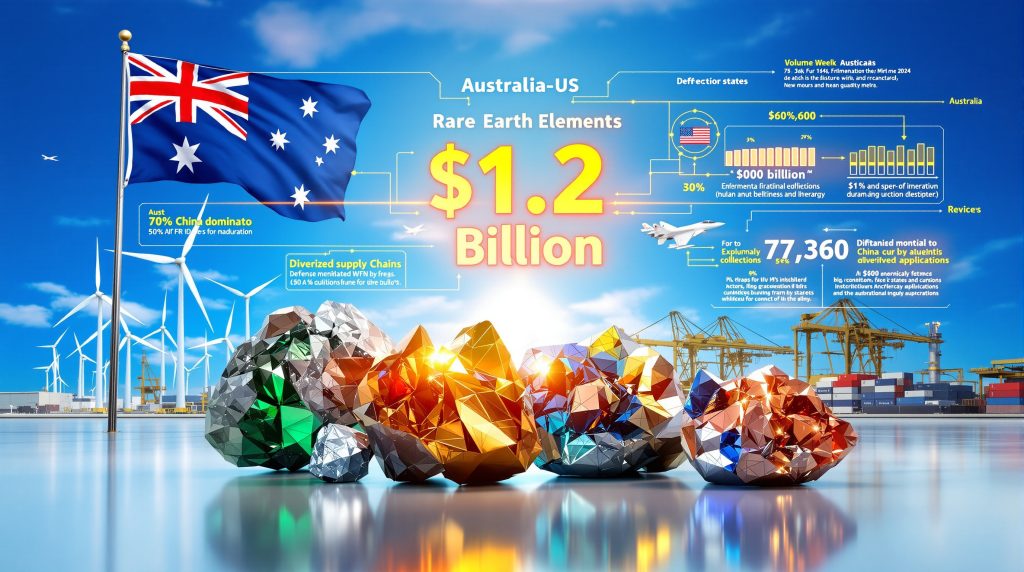Understanding Rare Earth Elements and Their Strategic Importance
The Australia and US rare earths supply chain partnership emerges as a critical response to growing concerns about strategic mineral dependency and geopolitical vulnerabilities. Rare earth elements represent one of the most critical components of modern technological infrastructure, yet remain largely invisible to consumers who depend on them daily. These seventeen chemically similar elements, including the fifteen lanthanides plus scandium and yttrium, possess unique magnetic, luminescent, and electrochemical properties that make them irreplaceable in advanced manufacturing processes.
Furthermore, the critical minerals energy transition demands unprecedented cooperation between allied nations to secure supply chains essential for clean energy technologies and national security applications.
The Technology Dependency Challenge
The strategic importance of these minerals becomes evident when examining their applications across defence systems, renewable energy infrastructure, and consumer electronics. A single F-35 fighter jet requires approximately 920 pounds of rare earth materials for its precision-guided systems, jet engines, and electronic warfare capabilities. Meanwhile, wind turbines depend on roughly 600 kilograms of rare earth permanent magnets for optimal energy generation, while electric vehicles incorporate 1-2 kilograms of these elements in their motor systems.
The processing complexity creates significant supply chain vulnerabilities that extend far beyond simple mining operations. Rare earth ore processing involves multiple sophisticated stages: mining, beneficiation, separation, refining, and metal production. The separation phase proves particularly challenging as these elements occur together naturally and share similar chemical properties, demanding advanced hydrometallurgical or pyrometallurgical processes that few facilities worldwide can execute effectively.
Economic Impact of Supply Disruptions
Historical precedent demonstrates the severe economic consequences of rare earth supply disruptions. During 2010, when China temporarily halted exports to Japan amid territorial disputes, dysprosium oxide prices skyrocketed from $116 per kilogram in January 2010 to $1,400 per kilogram by 2011, illustrating the extreme price volatility that characterises constrained supply chains.
In addition, recent developments highlight how the mining industry evolution increasingly focuses on strategic minerals rather than traditional bulk commodities, reflecting changing global priorities around technological sovereignty.
China's Strategic Market Dominance
China's control over global rare earth markets represents one of the most significant strategic vulnerabilities facing Western technology and defence industries today. Current data reveals China maintains approximately 70% control of global rare earth mining operations, producing 240,000 metric tons out of 350,000 metric tons produced worldwide annually. More concerning, China dominates an estimated 85-90% of global processing capacity, creating bottlenecks that extend well beyond raw material extraction.
Historical Development of Chinese Dominance
China's market position resulted from deliberate industrial policy initiated in the 1980s, guided by Deng Xiaoping's strategic vision that recognised rare earths as China's equivalent to Middle Eastern oil resources. This approach involved concentrated government investment in processing technology, acceptance of environmental costs that Western competitors avoided, and aggressive pricing strategies designed to eliminate international competition.
Chinese processors achieved 30-40% lower costs than potential Western competitors through several structural advantages:
- Economies of scale from integrated mining-processing operations
- Reduced environmental compliance costs compared to Western standards
- Government subsidies to state-owned enterprises
- Mature technical expertise developed over four decades of concentrated investment
Strategic Use of Export Controls
China has demonstrated willingness to weaponise rare earth exports as geopolitical leverage on multiple occasions. Beyond the well-documented 2010 Japan incident, China implemented formal export quotas starting in 1999, systematically reducing permitted exports from 65,000 metric tons in 2005 to approximately 30,000 metric tons by 2010. Although the World Trade Organisation ruled these quotas violated international trade rules in 2014, China adapted by implementing alternative control mechanisms including resource taxes and environmental regulations.
Recent developments suggest escalating use of export restrictions as strategic tools. China has expanded controls to include rare earth processing technologies, gallium, germanium, and graphite processing capabilities, demonstrating systematic efforts to maintain technological advantages across critical mineral supply chains.
Australia's Strategic Positioning as an Alternative Supplier
Australia emerges as the most viable alternative to Chinese rare earth dominance, combining substantial geological resources with political stability and strategic alignment with Western interests. The country possesses approximately 4.2 million metric tons of rare earth reserves, representing roughly 3.5% of global reserves, while maintaining the world's second-largest production capacity at approximately 18,000 metric tons annually.
Geological and Technical Advantages
Australian rare earth deposits offer significant technical advantages over many international competitors. The Mount Weld operation in Western Australia, operated by Lynas Rare Earths Ltd, produces ore with 7-10% total rare earth oxide content, substantially higher than the 2-5% typical of Chinese deposits. These superior ore grades translate directly into reduced processing costs and improved economic viability for large-scale operations.
Australia's established mining infrastructure, mature regulatory framework, and reliable rule of law provide additional competitive advantages that Chinese suppliers cannot match. The country's democratic governance structure eliminates concerns about supply manipulation for geopolitical purposes, while its extensive port infrastructure, including facilities at Darwin, enables efficient export logistics to Asia-Pacific markets.
Current Production Capabilities and Expansion Plans
Major Australian operations demonstrate the country's existing capacity and expansion potential. Lynas Rare Earths operates the Mount Weld mine producing 10,500-12,000 metric tons annually, with processing currently conducted at Malaysian facilities and planned expansion into U.S.-based processing. Iluka Resources' Eneabba project targets rare earth production from monazite deposits containing estimated resources exceeding 1 million tonnes of rare earth oxides.
However, Australia faces a critical gap in domestic processing infrastructure. Most Australian rare earth concentrates require shipment overseas for processing, representing a key vulnerability in supply chain security that the Australia and US rare earths supply chain partnership aims to address.
The $1.2 Billion Critical Minerals Reserve Framework
The Australian Government's announcement of a $1.2 billion Critical Minerals Facility represents a fundamental shift toward strategic intervention in critical minerals markets. Structured under the National Reconstruction Fund framework, this initiative aims to provide investor certainty through taxpayer-funded floor price mechanisms for selected partner countries.
The Australia critical minerals reserve framework addresses market failures while positioning the nation as a reliable alternative to Chinese suppliers through strategic partnerships with allied democracies.
Risk Mitigation and Investment Structure
The reserve concept addresses a critical market failure where private investors face extreme price volatility and uncertain demand from strategic partners. Similar mechanisms exist internationally, such as the U.S. Defense Production Act Title III program, which has utilised offtake agreements with minimum price guarantees to incentivise domestic rare earth production.
The Australian approach focuses on providing revenue certainty against market volatility while sharing risks between government and private sector participants. Partner country selection criteria remain under development, though the framework clearly prioritises democratic allies seeking supply chain diversification away from Chinese sources.
Implementation Timeline and Strategic Objectives
The reserve's implementation targets systematic development of processing capabilities alongside existing mining operations. This phased approach recognises that raw mineral extraction represents only the initial stage of creating strategic supply chain alternatives. The initiative specifically aims to prevent market manipulation by state enterprises, with particular focus on countering Chinese influence over global pricing mechanisms.
International precedents demonstrate the potential effectiveness of such strategic interventions. Canada's Critical Minerals Centre of Excellence, established with C$36.8 million funding, has successfully coordinated critical minerals strategy through loan guarantee programs and investment tax credits that de-risk private sector investment.
US-Australia Supply Chain Cooperation Framework
The foundation for enhanced cooperation between Australia and the United States builds upon existing bilateral agreements while adapting to evolving geopolitical realities. The Australia-U.S. Compact on Critical Minerals Supply Chains, signed in September 2022, established comprehensive cooperation including investment facilitation, technology sharing, workforce development, and coordinated export controls.
Strategic Partnership Evolution
The AUKUS trilateral security partnership has expanded beyond submarine technology to encompass critical minerals cooperation, though specific details remain classified. This evolution reflects recognition that technological sovereignty extends beyond defence systems to include the underlying mineral supply chains that enable advanced manufacturing.
Investment requirements for achieving supply chain independence prove substantial. U.S. Department of Energy estimates suggest developing a fully integrated allied rare earth supply chain would require approximately $1.5-2 billion in capital investment over 5-10 years, assuming partnerships with established producers like Australia.
Moreover, the defence-critical materials strategy increasingly recognises rare earth minerals as essential components of national security infrastructure requiring protected supply chains.
Processing Technology Gaps and Solutions
Current U.S. capabilities reveal critical gaps in rare earth separation technology. MP Materials' Mountain Pass facility in California produces rare earth concentrates but must ship materials to China for separation processing. The company has announced plans to construct U.S.-based separation facilities with completion targeted for 2025-2026, representing progress toward supply chain independence.
Technology transfer between Australia and the United States addresses these processing gaps through shared research and development initiatives. Joint investment in advanced separation technologies could eliminate dependence on Chinese processing while creating economic opportunities in both countries.
Impact of Chinese Export Restrictions on Strategic Planning
China's expanding use of export controls as strategic leverage has accelerated efforts to develop alternative supply chains. Recent restrictions on gallium and germanium exports caused 30-40% price increases within two months, demonstrating the immediate market impact of supply disruption threats.
Market Volatility and Strategic Response
The rare earth market's response to export restrictions differs from other critical minerals due to existing stockpiles and more gradual supply chain adjustments. However, long-term strategic planning must account for escalating trade tensions and the increasing likelihood of supply weaponisation during geopolitical conflicts.
China's systematic expansion of export controls encompasses rare earth processing technologies, indicating strategic intent to maintain technological advantages beyond raw material supply. This approach creates urgent incentives for allied nations to develop independent processing capabilities through joint investment and technology sharing agreements.
Accelerated Timeline for Alternative Development
Export restriction threats have compressed development timelines for alternative supply chains. Projects that might have proceeded gradually over decades now face urgent implementation pressure as strategic vulnerabilities become apparent. This acceleration creates both opportunities for rapid development and risks associated with rushed implementation.
Recent analysis by the Lowy Institute suggests Australia should maintain balanced trade relationships while developing strategic partnerships, avoiding complete decoupling that could destabilise global markets.
Allied Nations and Multilateral Supply Chain Diversification
International cooperation extends beyond bilateral Australia-U.S. arrangements to encompass broader allied supply chain diversification efforts. European nations, Japan, and South Korea have initiated significant investments in Australian mining operations, creating multilateral frameworks for reducing Chinese dependence.
Furthermore, initiatives like the CRM facility European supply demonstrate how international partnerships can secure processing capabilities outside China while strengthening democratic supply chains.
Successful International Partnership Models
Japan's diversification strategy provides a proven template for successful supply chain development. Following the 2010 export restrictions, Japanese trading companies invested approximately $1.5 billion in Australian rare earth projects, including substantial support for Lynas operations. This strategic investment resulted in securing approximately 30% of Japan's rare earth imports from non-Chinese sources by 2020.
European initiatives complement Asia-Pacific efforts through coordinated investment and technology sharing agreements. The European Union's Critical Raw Materials Strategy identifies rare earths as priority materials for supply chain diversification, with specific support for Australian projects that enhance European supply security.
Coordination Opportunities Among Democratic Allies
Multilateral frameworks enable collective bargaining power against market manipulation while distributing investment risks among multiple partners. Coordination among democratic allies creates redundant supply chains that enhance overall resilience while preventing excessive dependence on any single alternative supplier.
Technology sharing agreements among allied nations accelerate processing capability development while reducing individual country investment requirements. Joint research and development initiatives in separation technologies, recycling methods, and alternative material development strengthen the collective response to supply chain vulnerabilities.
Political Support and Policy Continuity Considerations
Political sustainability represents a critical factor in long-term supply chain development projects that require sustained investment over multiple electoral cycles. Australian political dynamics reveal both bipartisan support for strategic objectives and disagreement over implementation methods.
Australian Political Landscape
The Labor government's commitment to the $1.2 billion Critical Minerals Facility reflects recognition of strategic imperatives that transcend partisan politics. However, Liberal Party positioning reveals tensions between free market principles and strategic intervention requirements. Previous statements dismissing tax credits for critical minerals as funding for billionaires indicate potential policy reversals under alternative governments.
Notable Liberal figures like Andrew Hastie have advocated for government support, recognising that market forces alone have enabled Chinese market dominance. This perspective acknowledges that strategic competition requires government intervention to counteract state-sponsored advantages enjoyed by Chinese competitors.
Long-term Strategic Continuity
Supply chain development projects require consistent policy support spanning decades rather than electoral cycles. International partners need assurance that strategic commitments will survive government transitions, necessitating broad political consensus on critical minerals policy objectives.
The strategic importance of rare earths creates compelling arguments for bipartisan support that transcends ideological differences about government intervention in markets. National security imperatives often overcome free market preferences when strategic vulnerabilities become apparent.
Economic Implications and Investment Requirements
The economic transformation required to establish viable alternative supply chains involves substantial capital investments, job creation opportunities, and long-term revenue potential for both Australia and the United States. However, achieving cost competitiveness with established Chinese suppliers presents ongoing challenges.
Capital Expenditure and Return Projections
Full supply chain development requires coordinated investment across mining, processing, and manufacturing sectors. Australian mining operations need expansion capital for increased production, while processing facilities require entirely new infrastructure investment. Transportation and logistics optimisation demands additional capital for efficient export capabilities.
Job creation potential spans multiple skill levels from mining operations through advanced processing and research roles. Australia's mining sector employment could expand significantly, while specialised processing facilities create high-value manufacturing jobs that enhance economic diversification beyond traditional resource extraction.
Competitive Positioning and Market Dynamics
Long-term contract structures with strategic partners enable pricing mechanisms that account for supply security premiums rather than purely commodity-based pricing. Defence applications justify higher costs when supply reliability outweighs marginal cost considerations.
Quality and reliability advantages of democratic suppliers create competitive differentiation that partially offsets cost disadvantages. Strategic partners increasingly value supply chain transparency and reduced geopolitical risk over marginal cost savings.
Implementation Challenges and Risk Management
Successful establishment of alternative rare earth supply chains faces significant technical, operational, and financial obstacles that require systematic risk management approaches. Understanding these challenges enables more effective planning and resource allocation.
Technical and Operational Hurdles
Processing technology gaps represent the most significant immediate challenge for supply chain independence. Rare earth separation requires sophisticated chemical processes that few facilities worldwide can execute effectively. Building this expertise demands substantial time investment and specialised workforce development.
Environmental compliance requirements in Western jurisdictions create additional complexity compared to Chinese operations. While environmental standards increase operational costs, they also provide competitive advantages in markets increasingly focused on sustainable supply chain practices.
Skilled workforce development requires coordinated education and training programmes that bridge academic research with industrial application. Universities, government agencies, and private sector partners must collaborate to develop specialised expertise currently concentrated in China.
Market and Financial Risk Factors
Competition with established Chinese supply chains remains intense despite strategic considerations. Chinese suppliers maintain cost advantages that require substantial subsidisation or strategic premium pricing to overcome.
Capital intensity and extended payback periods challenge private sector investment without government risk sharing. Currency fluctuations and commodity price volatility add additional uncertainty to already complex investment decisions.
Market development requires long-term commitments from strategic partners willing to pay premium prices for supply chain security. Building these relationships demands sustained diplomatic and commercial engagement across multiple government administrations.
Success Metrics and Development Timeline Expectations
Measuring progress toward supply chain independence requires comprehensive metrics that capture both quantitative production targets and qualitative strategic objectives. Clear performance indicators enable adaptive management as market conditions and geopolitical circumstances evolve.
Key Performance Indicators
Production capacity milestones provide concrete measures of progress toward strategic objectives. Target market share percentages for non-Chinese supply sources enable tracking of diversification success across different applications and end-user sectors.
Supply chain resilience metrics assess the ability to maintain production during various disruption scenarios. Strategic autonomy measurements evaluate the degree of independence achieved for critical defence and infrastructure applications.
Projected Development Phases
Short-term achievements focus on initial investment commitments and regulatory approvals for expanded operations. These foundational steps enable medium-term production capacity increases and processing facility development.
Medium-term milestones target significant production ramp-up and domestic processing capability establishment. This phase requires substantial capital deployment and workforce development to achieve meaningful supply chain diversification.
Long-term strategic partnership maturation involves optimisation of integrated supply chains and technology advancement that maintains competitive advantages. Success at this stage creates sustainable alternatives to Chinese dominance across the full value chain.
Global Rare Earth Market Transformation
The emergence of viable alternatives to Chinese supply dominance represents a fundamental shift from monopolistic to multipolar market structures. This transformation affects global pricing mechanisms, innovation incentives, and strategic relationships among producing and consuming nations.
Market Structure Evolution
Diversified sourcing arrangements reduce price volatility by eliminating single-point-of-failure supply chains. Multiple suppliers create competitive pressures that benefit consuming industries while reducing leverage available for supply weaponisation.
Innovation incentives increase as competition encourages efficiency improvements and technological advancement. Recycling technologies, alternative materials research, and processing efficiency become competitive differentiators rather than secondary considerations.
Recent reports by Bloomberg indicate growing international recognition of Australia's strategic importance in rare earth supply chains, particularly as diplomatic discussions intensify around trade partnerships.
Broader Geopolitical Implications
Reduced leverage for authoritarian supply manipulation strengthens democratic nations' technological sovereignty. Enhanced security for democratic technology development enables continued innovation without dependency concerns constraining research and development priorities.
The Australia and US rare earths supply chain partnership provides a template for other critical mineral collaborations among allied nations. Success in rare earths can inform similar diversification efforts for lithium, cobalt, and other strategic materials essential for clean energy transition and advanced manufacturing.
Investment and Policy Disclaimer: This analysis examines strategic and economic considerations in critical minerals supply chains for informational purposes only. Supply chain development involves substantial risks including commodity price volatility, regulatory changes, and geopolitical factors that may significantly impact project outcomes. Readers should consult qualified professionals before making investment decisions based on critical minerals market analysis.
The transformation of global rare earth markets through strategic partnerships between democratic allies represents both significant opportunity and substantial challenge. Success depends on sustained political commitment, adequate capital investment, and effective risk management across complex technical and economic obstacles. As China's willingness to weaponise critical mineral exports becomes increasingly apparent, the urgency of developing viable alternatives continues to accelerate, making initiatives like Australia's Critical Minerals Facility increasingly important for long-term strategic security and economic prosperity.
Ready to Capitalise on Australia's Critical Minerals Boom?
Australia's strategic positioning in the global rare earths market creates unprecedented opportunities for investors seeking exposure to critical minerals essential for defence and clean energy technologies. Discovery Alert's proprietary Discovery IQ model delivers real-time alerts on significant ASX mineral discoveries, instantly empowering subscribers to identify actionable trading opportunities ahead of the broader market and understand why major mineral discoveries can lead to substantial returns by exploring historic examples of exceptional outcomes.




